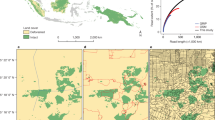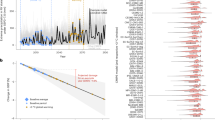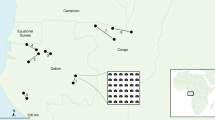Abstract
Climate change threatens the health and survival of urban trees and the various benefits they deliver to urban inhabitants. Here, we show that 56% and 65% of species in 164 cities across 78 countries are currently exceeding temperature and precipitation conditions experienced in their geographic range, respectively. We assessed 3,129 tree and shrub species, using three metrics related to climate vulnerability: exposure, safety margin and risk. By 2050 under Representative Concentration Pathway 6.0, 2,387 (76%) and 2,220 (70%) species will be at risk from projected changes in mean annual temperature and annual precipitation, respectively. Risk is predicted to be greatest in cities at low latitudes—such as New Delhi and Singapore—where all urban tree species are vulnerable to climate change. These findings aid the evaluation of the impacts of climate change to secure long-term benefits provided by urban forests.
This is a preview of subscription content, access via your institution
Access options
Access Nature and 54 other Nature Portfolio journals
Get Nature+, our best-value online-access subscription
$29.99 / 30 days
cancel any time
Subscribe to this journal
Receive 12 print issues and online access
$209.00 per year
only $17.42 per issue
Buy this article
- Purchase on Springer Link
- Instant access to full article PDF
Prices may be subject to local taxes which are calculated during checkout



Similar content being viewed by others
Data availability
The data generated and analysed for this study have been deposited on Figshare: https://figshare.com/projects/Climate_change_increases_global_risk_to_urban_forests/144039
Code availability
All data were edited and analysed in R v.4.0.5 (ref. 52) and Microsoft Excel v.16.17.27 (201012). The complete codes used to generate and visualize the results reported in this study have been deposited on Figshare: https://figshare.com/projects/Climate_change_increases_global_risk_to_urban_forests/144039
Change history
14 October 2022
In the version of this article initially published, the surname of Maria A. Perez-Navarro was missing from the Peer review information section, and has now been restored to the HTML and PDF versions of the article.
References
Liu, Z., He, C., Zhou, Y. & Wu, J. How much of the world’s land has been urbanized, really? A hierarchical framework for avoiding confusion. Landsc. Ecol. 29, 763–771 (2014).
The World’s Cities in 2018: Data Booklet (UN, 2018).
Miller, R. W., Hauer, R. J. & Werner, L. P. Urban Forestry: Planning and Managing Urban Greenspaces 3rd edn (Waveland Press, 2015).
Escobedo, F. J., Kroeger, T. & Wagner, J. E. Urban forests and pollution mitigation: analyzing ecosystem services and disservices. Environ. Pollut. 159, 2078–2087 (2011).
Keeler, B. L. et al. Social-ecological and technological factors moderate the value of urban nature. Nat. Sustain. 2, 29 (2019).
Petri, A. C., Koeser, A. K., Lovell, S. T. & Ingram, D. How green are trees?—using life cycle assessment methods to assess net environmental benefits. J. Environ. Hortic. 34, 101–110 (2016).
Bastin, J.-F. et al. The global tree restoration potential. Science 365, 76–79 (2019).
IPCC Climate Change 2021: The Physical Science Basis (eds Masson-Delmotte, V. et al.) (Cambridge Univ. Press, 2021).
Van Mantgem, P. J. et al. Widespread increase of tree mortality rates in the western United States. Science 323, 521–524 (2009).
Nowak, D. J. & Greenfield, E. J. Declining urban and community tree cover in the United States. Urban For. Urban Green. 32, 32–55 (2018).
Easterling, D. R. et al. Climate extremes: observations, modeling, and impacts. Science 289, 2068–2074 (2000).
Zscheischler, J. et al. Future climate risk from compound events. Nat. Clim. Change 8, 469–477 (2018).
Yan, P. & Yang, J. Performances of urban tree species under disturbances in 120 cities in China. Forests 9, 50 (2018).
Hilbert, D., Roman, L., Koeser, A. K., Vogt, J. & Van Doorn, N. S. Urban tree mortality: a literature review. Arboric. Urban For. 45, 167–200 (2019).
Young, R. F. & McPherson, E. G. Governing metropolitan green infrastructure in the United States. Landsc. Urban Plan. 109, 67–75 (2013).
Esperon-Rodriguez, M. et al. Assessing climate risk to support urban forests in a changing climate. Plants People Planet https://doi.org/10.1002/ppp3.10240 (2022).
Esperon-Rodriguez, M. et al. Assessing the vulnerability of Australia’s urban forests to climate extremes. Plants People Planet 1, 387–397 (2019).
Gallagher, R. V., Allen, S. & Wright, I. J. Safety margins and adaptive capacity of vegetation to climate change. Sci. Rep. 9, 8241 (2019).
Bertrand, R. et al. Changes in plant community composition lag behind climate warming in lowland forests. Nature 479, 517–520 (2011).
Bertrand, R. et al. Ecological constraints increase the climatic debt in forests. Nat. Commun. 7, 12643 (2016).
Richard, B. et al. The climatic debt is growing in the understory of temperate forests: stand characteristics matter. Global Ecol. Biogeogr. 30, 1474–1487 (2021).
IPCC Climate Change 2001: The Scientific Basis (eds Houghton, J. T. et al.) (Cambridge Univ. Press, 2001).
Dawson, T. P., Jackson, S. T., House, J. I., Prentice, I. C. & Mace, G. M. Beyond predictions: biodiversity conservation in a changing climate. Science 332, 53–58 (2011).
Foden, W. B. et al. Climate change vulnerability assessment of species. WIREs Clim. Change 10, e551 (2019).
Pacifici, M. et al. Assessing species vulnerability to climate change. Nat. Clim. Change 5, 215–224 (2015).
Reisinger, A. et al. The Concept of Risk in the IPCC Sixth Assessment Report: A Summary of Cross-Working Group Discussions (IPCC, 2020).
Chen, C. et al. University of Notre Dame Global Adaptation Index: Country Index Technical Report (ND-GAIN, 2015).
McPherson, E. G., Berry, A. M. & van Doorn, N. S. Performance testing to identify climate-ready trees. Urban For. Urban Green. 29, 28–39 (2018).
Soberón, J. & Peterson, A. T. Interpretation of models of fundamental ecological niches and species’ distributional areas. Biodivers. Inform. 2 https://doi.org/10.17161/bi.v2i0.4 (2005).
Pulliam, H. R. On the relationship between niche and distribution. Ecol. Lett. 3, 349–361 (2000).
Ordóñez, C. & Duinker, P. Assessing the vulnerability of urban forests to climate change. Environ. Rev. 22, 311–321 (2014).
Gallagher, R. V., Beaumont, L. J., Hughes, L. & Leishman, M. R. Evidence for climatic niche and biome shifts between native and novel ranges in plant species introduced to Australia. J. Ecol. 98, 790–799 (2010).
Smith, I. A., Dearborn, V. K. & Hutyra, L. R. Live fast, die young: accelerated growth, mortality, and turnover in street trees. PLoS ONE 14, e0215846 (2019).
Hirabayashi, Y., Kanae, S., Emori, S., Oki, T. & Kimoto, M. Global projections of changing risks of floods and droughts in a changing climate. Hydrol. Sci. J. 53, 754–772 (2008).
Van der Veken, S., Hermy, M., Vellend, M., Knapen, A. & Verheyen, K. Garden plants get a head start on climate change. Front. Ecol. Environ. 6, 212–216 (2008).
Ballinas, M. & Barradas, V. L. Transpiration and stomatal conductance as potential mechanisms to mitigate the heat load in Mexico City. Urban For. Urban Green. 20, 152–159 (2016).
Di Baldassarre, G. et al. Water shortages worsened by reservoir effects. Nat. Sustain. 1, 617 (2018).
Hoekstra, A. Y. & Mekonnen, M. M. The water footprint of humanity. Proc. Natl Acad. Sci. USA 109, 3232–3237 (2012).
Manoli, G. et al. Magnitude of urban heat islands largely explained by climate and population. Nature 573, 55–60 (2019).
Kim, D.-H., Doyle, M. R., Sung, S. & Amasino, R. M. Vernalization: winter and the timing of flowering in plants. Annu. Rev. Cell Dev. Biol. 25, 277–299 (2009).
Kummu, M. & Varis, O. The world by latitudes: a global analysis of human population, development level and environment across the north–south axis over the past half century. Appl. Geogr. 31, 495–507 (2011).
Vogt, J. et al. Citree: a database supporting tree selection for urban areas in temperate climate. Landsc. Urban Plan. 157, 14–25 (2017).
Paquette, A. et al. Praise for diversity: a functional approach to reduce risks in urban forests. Urban For. Urban Green. 62, 127157 (2021).
Esperon-Rodriguez, M. et al. Functional adaptations and trait plasticity of urban trees along a climatic gradient. Urban For. Urban Green. 54, 126771 (2020).
Hirons, A. D. et al. Using botanic gardens and arboreta to help identify urban trees for the future. Plants People Planet 3, 182–193 (2021).
Watkins, H., Hirons, A., Sjöman, H., Cameron, R. & Hitchmough, J. D. Can trait-based schemes be used to select species in urban forestry? Front. Sustain. Cities 3 https://doi.org/10.3389/frsc.2021.654618 (2021).
Populated Places (Natural Earth, accessed 2018); http://www.naturalearthdata.com/downloads/
Ossola, A. et al. The Global Urban Tree Inventory: a database of the diverse tree flora that inhabits the world’s cities. Glob. Ecol. Biogeogr. 29, 1907–1914 (2020).
Sabatini, F., Lenoir, J. & Bruelheide, H. sPlotOpen—An Environmentally-Balanced, Open-Access, Global Dataset of Vegetation Plots (iDiv, 2021); https://doi.org/10.25829/idiv.3474-40-3292
Sabatini, F. M. et al. sPlotOpen—an environmentally balanced, open-access, global dataset of vegetation plots. Global Ecol. Biogeogr. 30, 1740–1764 (2021).
Zizka, A. et al. CoordinateCleaner: standardized cleaning of occurrence records from biological collection databases. Methods Ecol. Evol. 10, 744–751 (2019).
R Core Team. R: A Language and Environment for Statistical Computing (R Foundation for Statistical Computing, 2021).
Taxonstand: Taxonomic standardization of plant species names. R package version 2.4 https://cran.r-project.org/web/packages/Taxonstand/Taxonstand.pdf (2021).
Kelso, N. & Patterson, T. World Urban Areas, LandScan, 1:10 Million (2012) (North American Cartographic Information Society, 2012).
Karger, D. N. et al. Climatologies at high resolution for the earth’s land surface areas. Sci. Data 4, 170122 (2017).
O’Donnell, M. S. & Ignizio, D. A. Bioclimatic Predictors for Supporting Ecological Applications in the Conterminous United States (USGS, 2012).
Field, C. et al. IPCC, 2014: Climate Change 2014: Impacts, Adaptation, and Vulnerability. Part A: Global and Sectoral Aspects. Contribution of Working Group II to the Fifth Assessment Report of the Intergovernmental Panel on Climate Change (Cambridge Univ. Press, 2014).
Meinshausen, M. et al. The RCP greenhouse gas concentrations and their extensions from 1765 to 2300. Clim. Change 109, 213–241 (2011).
Zhao, L. et al. Global multi-model projections of local urban climates. Nat. Clim. Change 11, 152–157 (2021).
Huang, K., Li, X., Liu, X. & Seto, K. C. Projecting global urban land expansion and heat island intensification through 2050. Environ. Res. Lett. 14, 114037 (2019).
Alavipanah, S., Wegmann, M., Qureshi, S., Weng, Q. & Koellner, T. The role of vegetation in mitigating urban land surface temperatures: a case study of Munich, Germany during the warm season. Sustainability 7, 4689–4706 (2015).
Corburn, J. Cities, climate change and urban heat island mitigation: localising global environmental science. Urban Stud. 46, 413–427 (2009).
Baston, D., ISciences, L.L., Baston, M.D. Package ‘exactextractr’. terra. R package version 0.8.2 (2022).
Hijmans, R. J. et al. raster: Geographic data analysis and modeling. R package version 2.3-33 http://cran.r-project.org/web/packages/raster/index.html (2016).
Bates, D., Mächler, M., Bolker, B. & Walker, S. Fitting linear mixed-effects models using lme4. J. Stat. Softw. 67, 1–48 (2015).
Bivand, R. et al. maptools: Tools for handling spatial objects. R package version 08, 23 https://cran.r-project.org/web/packages/maptools/ (2013).
Acknowledgements
We gratefully acknowledge L. Staas for her support of the project and S. Allen for programming assistance. M.E.R., L.J.B., S.A.P., P.D.R., M.G.T. and R.V.G. received funding from the Hort Frontiers Green Cities Fund, part of the Hort Frontiers strategic partnership initiative developed by Hort Innovation, with co-investment from Macquarie University, Western Sydney University and the NSW Department of Planning, Industry and Environment and contributions from the Australian Government. We thank P. B. Reich for his feedback.
Author information
Authors and Affiliations
Contributions
M.E.R., R.V.G., P.D.R., S.A.P. and M.G.T. conceived the article. M.E.R., R.V.G., L.J.B., P.D.R., S.A.P. and M.G.T. designed the research. M.E.R., J.B.B., D.A.N., R.V.G., J.L. and B.R. collected, provided code and analysed data. M.E.R. wrote the first draft of the article. All authors contributed to the discussion of the content and reviewed or edited the manuscript before submission. All authors, except for M.E.R., M.T.G., J.L. and R.V.G., are listed alphabetically.
Corresponding author
Ethics declarations
Competing interests
The authors declare no competing interests.
Peer review
Peer review information
Nature Climate Change thanks Maria A. Perez-Navarro, Kangning Huang and Hua Lin for their contribution to the peer review of this work.
Additional information
Publisher’s note Springer Nature remains neutral with regard to jurisdictional claims in published maps and institutional affiliations.
Extended data
Extended Data Fig. 1 Exposure to future climate change across the world’s cities.
Changes (i.e. exposure) in maximum temperature of the warmest month (A), minimum temperature of the coldest month (B), annual precipitation (C), and precipitation of the driest quarter (D) predicted to occur by 2050. Data for Representative Concentration Pathway 6.0.
Extended Data Fig. 2 Contemporary tree and shrub species safety margin across the world’s cities.
Proportion of tree and shrub species presently exceeding their current safety margin for maximum temperature of the warmest month (MTWM; A), minimum temperature of the coldest month (MTCM; C), and precipitation of the driest quarter (PDQ; E) in 164 cities where they are planted. Frequency distribution of mean values of MTWM (B), MTCM (D) and PDQ (F) safety margin of each species (n = 3,129). Red and blue lines indicate the median and 5th/95th percentiles, respectively. A positive safety margin (S > 0) indicates that the species has a climatic tolerance limit that exceeds climatic conditions; whereas a negative value (S < 0) indicates that the species is subject to ‘unsafe’ climatic conditions outside its climatic tolerance limits.
Extended Data Fig. 3 Tree and shrub species at risk of future climate change impacts across the world’s cities.
Proportion of plant species predicted to be at risk of changes in maximum temperature of the warmest month (A), minimum temperature of the coldest month (B), and precipitation of the driest quarter (C) in 164 cities where they are planted. Data for 2050 and Representative Concentration Pathway 6.0.
Supplementary information
Supplementary Information
Supplementary Table 1–6, Figs. 1–11 and references.
Supplementary Data
Supplementary Data 1, Species safety margins and risks. Supplementary Data 2, Niche breadth of all species (n = 3,129) planted in 164 cities.
Rights and permissions
Springer Nature or its licensor holds exclusive rights to this article under a publishing agreement with the author(s) or other rightsholder(s); author self-archiving of the accepted manuscript version of this article is solely governed by the terms of such publishing agreement and applicable law.
About this article
Cite this article
Esperon-Rodriguez, M., Tjoelker, M.G., Lenoir, J. et al. Climate change increases global risk to urban forests. Nat. Clim. Chang. 12, 950–955 (2022). https://doi.org/10.1038/s41558-022-01465-8
Received:
Accepted:
Published:
Issue Date:
DOI: https://doi.org/10.1038/s41558-022-01465-8
This article is cited by
-
Effects of urban, peri-urban and rural land covers on plant functional traits around Bogotá, Colombia
Urban Ecosystems (2024)
-
Nature can cool cities, but proceed with caution
Urban Transformations (2023)
-
Global mapping of urban nature-based solutions for climate change adaptation
Nature Sustainability (2023)
-
Warming amplifies urbanization effects on mammals
Nature Ecology & Evolution (2023)
-
Rootability confinement and soil-husbandry solutions for urban trees in sealed and insular sites
Plant and Soil (2023)



